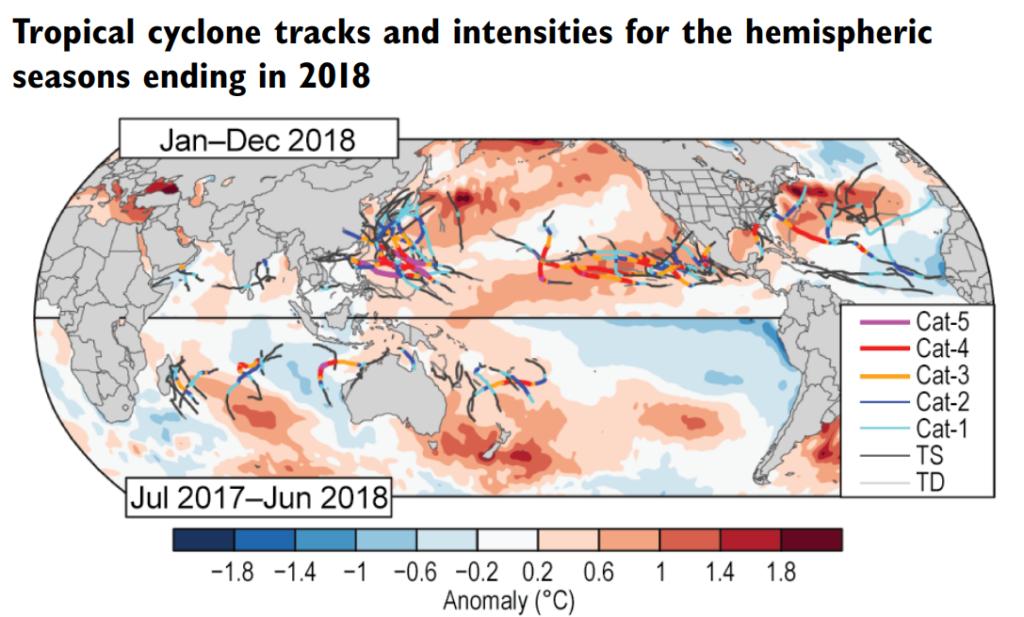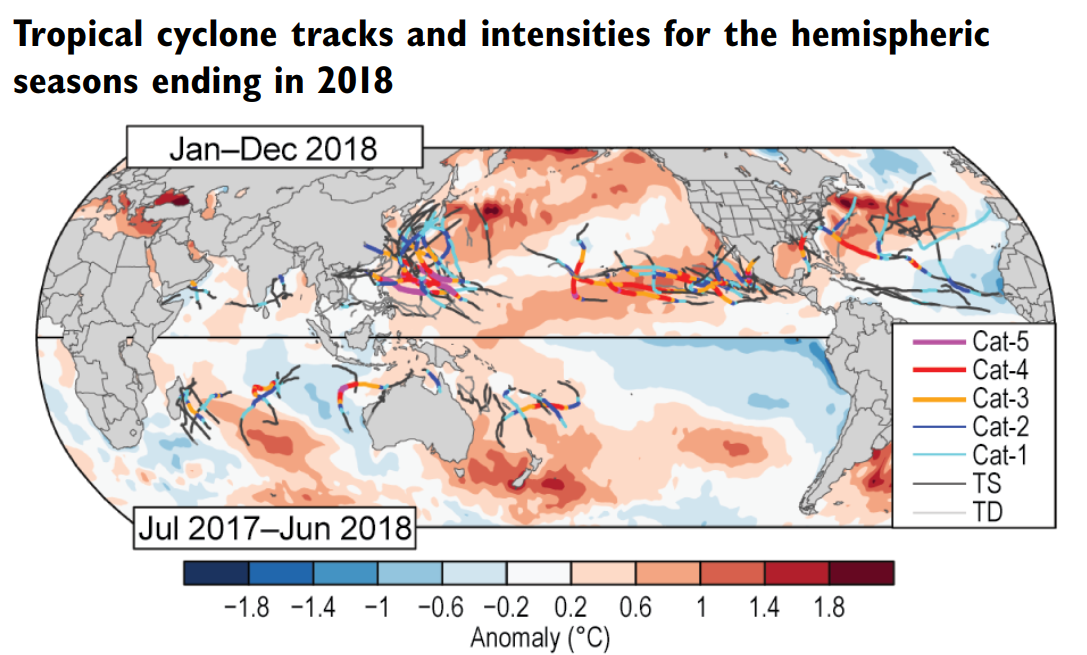
Wind damage to forests is a large and increasing threat in many parts of the world. In particular with the changing climate there is predicted to be an intensification of tropical cyclones with a northward migration to higher latitudes (Figure 1). This will mean that intense winds from remnant hurricanes are likely to become more common during the autumn in countries along the Atlantic coast and around the North Sea. In addition there is increasing evidence for damage to forests and urban trees from intense thunderstorms and thunderstorm squall lines during the summer in central and eastern Europe (https://www.bbc.com/news/world-europe-40959863).
However, to date no one has measured the process of tree failure during an intense storm. This means that the actual failure mechanism has been the subject of conjecture based on tree pulling experiments, post-storm observations and video evidence. On 1 October 2018 super-typhoon Trami caused devastation across the main island of Japan (https://www.ouest-france.fr/monde/japon/trami-un-nouveau-super-typhon-frappe-le-japon-et-fait-des-blesses-5992961). Fortuitously a colleague in Japan, Dr Kana Kamimura of Shinshu University, Japan was monitoring the movements and wind loads on a number of genetically similar cryptomeria japonica trees in an unthinned and a thinned plot. A number of trees failed during the storm, but only in the recently thinned plot (thinned the previous year) and amazingly, despite the intense winds and damage to trees, data was available from 20 trees in the unthinned plot and 9 trees in the thinned plot.
Now after in depth analysis, and dealing with problems due to lost periods of data during the storm, an article documenting the behaviour of the trees during the typhoon and the exact failure mechanism has been published in the prestigious journal Science Advances with authors from Japan (Kana Kamimura, Kazuki Nanko, Asako Matsumoto, Saneyoshi Ueno), France (Barry Gardiner) and the UK (James Gardiner) (Kamimura et al., 2022).
The key message of the paper is that trees are vulnerable immediately following thinning because of the removal of neighbours. These neighbours provide increased “stiffness” and damping to the subject tree because of almost continuous crown clashing in the unthinned plot (https://youtu.be/pW9oMKlmcG8) that reduces the force from the wind that is transmitted through the stem into the root/soil system. However, in the thinned plot, with all immediate neighbours removed, the trees are freer to move and the damping from collisions is substantially reduced. We observed that these trees moved in an erratic manner and following a rapid increase in wind speed as the storm intensified these trees started to lean further and further from their initial position.
Some trees were uprooted and fell but even the undamaged trees in the thinned plot were left leaning slightly after the passage of the typhoon. In contrast all the trees in the unthinned plot returned to their initial positions. The overturning of the damaged trees was not immediate and took place over a period of one to two hours. Some trees had damage to multiple small roots and the damage process was relatively slow. In other trees there is clear evidence of damage to a substantial root early in the period of intense winds and the process of failure was more rapid.
The lesson for forest management from this study is that the interaction of tree crowns in the forest canopy is crucial for the stability of trees during strong winds. Any disturbance to the forest that reduces this crown interaction, such as thinning, immediately reduces the stability of the trees. With time the crown will grow and the trees will adjust to their new wind environment by increasing their root size and stem diameter (Dèfossez et al., 2021; Nicoll et al., 2019). After this adjustment these thinned trees will become more stable than the unthinned trees (Mason and Valinger, 2013). The importance of crown interaction may also be the reason that irregular stands are more stable (Mason, 2002; Pukkala et al., 2016) and why selective thinning is a more sensible option in regions with a windy climate or for forest stands with trees large enough to be vulnerable to wind damage (Kerr and Haufe, 2011; Pommerening and Murphy, 2004).
Barry Gardiner
IEFC, Pierroton
17 February 2022
References
Blunden, J., Arndt, D.S., 2019. State of the Climate in 2018. Bull. Am. Meteorol. Soc. 100. https://doi.org/doi:10.1175/2019BAMSStateoftheClimate.1.
Dèfossez, P., Rajaonalison, F., Bosc, A., 2021. How wind acclimation impacts Pinus pinaster growth in comparison to resource availability. For. An Int. J. For. Res. 1–12. https://doi.org/10.1093/forestry/cpab028
Kamimura, K., Nanko, K., Matsumoto, A., Ueno, S., Gardiner, J., Gardiner, B., 2022. Tree dynamic response and survival in a category-5 tropical cyclone : The case of super typhoon Trami. Sci. Adv. 8, 1–11.
Kerr, G., Haufe, J., 2011. Thinning Practice: A Silvicultural Guide. Forestry Commission, Edinburgh.
Mason, B., Valinger, E., 2013. Managing forests to reduce storm damage, in: Gardiner, B., Schuck, A., Schelhaas, M.-J., Orazio, C., Blennow, K., Nicoll, B. (Eds.), Living with Storm Damage to Forests: What Science Can Tell Us. European Forest Institute, pp. 89–98.
Mason, W.L., 2002. Are irregular stands more windfirm ? 75.
Nicoll, B.C., Connolly, T., Gardiner, B.A., 2019. Changes in spruce growth and biomass allocation following thinning and guying treatments. Forests 10, 253. https://doi.org/10.3390/f10030253
Pommerening, A., Murphy, S.T., 2004. A review of the history, definitions and methods of continuous cover forestry with special attention to afforestation and restocking. Forestry. https://doi.org/10.1093/forestry/77.1.27
Pukkala, T., Laiho, O., Lähde, E., 2016. Continuous cover management reduces wind damage. For. Ecol. Manage. 372, 120–127. https://doi.org/10.1016/j.foreco.2016.04.014

